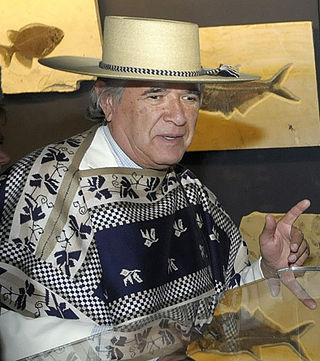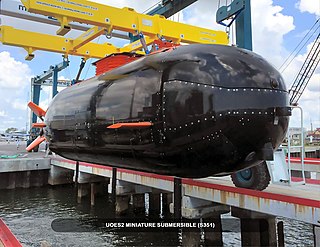
A diver propulsion vehicle (DPV), also known as an underwater propulsion vehicle, sea scooter, underwater scooter, or swimmer delivery vehicle (SDV) by armed forces, is an item of diving equipment used by scuba divers to increase range underwater. Range is restricted by the amount of breathing gas that can be carried, the rate at which that breathing gas is consumed, and the battery power of the DPV. Time limits imposed on the diver by decompression requirements may also limit safe range in practice. DPVs have recreational, scientific and military applications.

A midget submarine is any submarine under 150 tons, typically operated by a crew of one or two but sometimes up to six or nine, with little or no on-board living accommodation. They normally work with mother ships, from which they are launched and recovered and which provide living accommodation for the crew and support staff.

The SEAL Delivery Vehicle (SDV) is a crewed submersible and a type of swimmer delivery vehicle used to deliver United States Navy SEALs and their equipment for special operations missions. It is also operated by the Royal Navy's Special Boat Service, which operates three SDVs.

Human torpedoes or manned torpedoes are a type of diver propulsion vehicle on which the diver rides, generally in a seated position behind a fairing. They were used as secret naval weapons in World War II. The basic concept is still in use.
The Poseidon, previously known by Russian codename Status-6, is an autonomous, nuclear-powered unmanned underwater vehicle reportedly in production by Rubin Design Bureau, capable of delivering both conventional and nuclear warheads.

A deep-submergence rescue vehicle (DSRV) is a type of deep-submergence vehicle used for rescue of downed submarines and clandestine missions. While DSRV is the term most often used by the United States Navy, other nations have different designations for their vehicles.

The Advanced SEAL Delivery System (ASDS) was a midget submarine operated by the United States Navy and United States Special Operations Command. It provided stealthy submerged transportation for United States Navy SEALs from the decks of nuclear submarines for use as an insertion platform for covert and clandestine special operations missions. The ASDS was canceled in 2009 due to cost overruns and reliability issues, after the prototype was destroyed in a fire in 2008. As of 2019, the Navy plans to replace the ASDS with the Dry Combat Submersible, a similar midget submarine being developed by Lockheed Martin.

A wet sub is a type of underwater vehicle, either a submarine or a submersible, that does not provide a dry environment for its occupants. It is also described as an underwater vehicle where occupants are exposed to ambient environment during operations. The watercraft is classified as medium-sized or small vessel. This type of submarine differs from other underwater personal transport devices by the fact that it has a hull around it and it is not a "bare bones" design.
The Jianggezhuang Naval Base is a Chinese naval base approximately 15 miles east of Qingdao on the Yellow Sea. The base spans a bay 1.2 miles across, with the main facilities located in the eastern portion of the bay. Open source satellite imagery shows the base to be an enclosed harbour with breakwaters and a single entrance; there are six piers, a dry dock, various service facilities and an underground submarine tunnel.

Carlos Remigio Cardoen Cornejo is a Chilean arms dealer, metallurgical engineer, weapons scientist and agricultural businessman.

The Cosmos-class submarine, officially Cos.Mo.S MG-110 locally designated as X-Craft, are the class of midget submarines designed by the Italian firm Cos.Mo.S, in Karachi Naval Dockyard in Karachi, Sindh, Pakistan.
The SX-404-class submarine, was a class of midget submarines produced by the Italian firm Cos.Mo.S.
CosMoS CE2F were a series of Swimmer Delivery Vehicle (SDV) built by M/s Cos.Mo.S Spa. which was based in Livorno, Italy.
A semi-submersible naval vessel is a hybrid warship, that combines the properties of a surface ship and submarine by using water ballast to partially immerse and minimize its above-waterline profile, thereby improving its stealth characteristics when in hostile waters. The USS Monitor was an antecedent to such craft with its low-profile deck and gun turret. Russian and North Korean semi-submersible naval vessels evolved from torpedo boats and special forces boats that could partially submerge to perform their missions. The US Navy SEALs use such vessels for clandestine special forces actions. Efforts to embody advantageous surface-ship characteristics into submarines have not been widely adopted.

The Shallow Water Combat Submersible (SWCS) is a crewed submersible and a type of swimmer delivery vehicle that is planned to be used to deliver United States Navy SEALs and their equipment for special operations missions. It will replace the current Mark 8 SEAL Delivery Vehicle. The Navy planned to introduce the SWCS in 2018, although "slippage in the development" has delayed its introduction until 2019. In 2020, the U.S. Navy stated that it was undergoing sea trials and testing. As of October 2018, two subs have been delivered to the Navy while another two were in production. The SWCS will serve alongside the Dry Combat Submersible (DCS), a midget submarine with a dry interior being developed by Lockheed Martin as a replacement for the cancelled Advanced SEAL Delivery System (ASDS).

The Dry Combat Submersible (DCS) is a midget submarine delivered to USSOCOM by Lockheed Martin.
CABI Cattaneo is an Italian boat and submersible builder which primarily supplies the Special Operations Forces market. Due to the nature of their work they are extremely secretive.
Drass, or DRASS, is an Italian manufacturing company headquartered in Livorno, whose best known for their range of midget submarine and swimmer delivery vehicle. They also have a line of hyperbaric chambers for diver decompression.
HSU-001 is a class of Chinese unmanned underwater vehicle.












